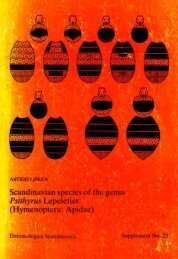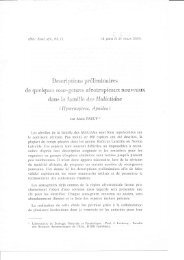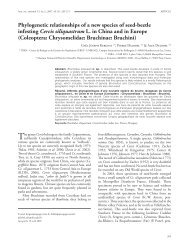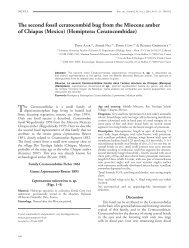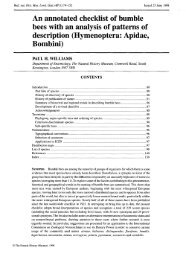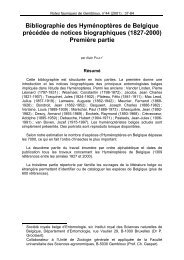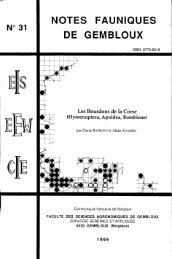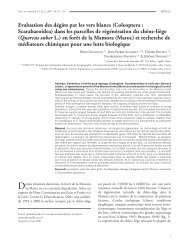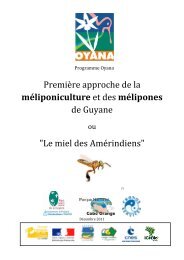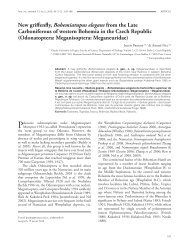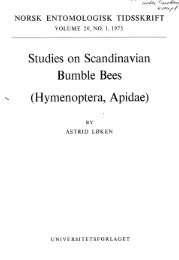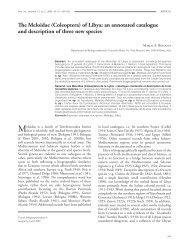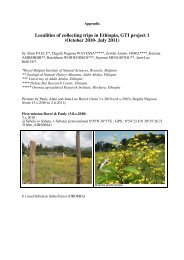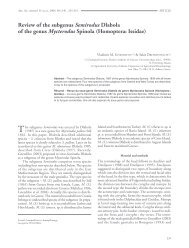ASEF 4-2009.indb - Laboratoire de Zoologie
ASEF 4-2009.indb - Laboratoire de Zoologie
ASEF 4-2009.indb - Laboratoire de Zoologie
You also want an ePaper? Increase the reach of your titles
YUMPU automatically turns print PDFs into web optimized ePapers that Google loves.
Type Specimens at the QCAZ Museum<br />
biological collections in the Museum did not have specifi c or<br />
complete geographic coordinates. We increased the number<br />
of known locations by submitting the label data information<br />
to a strict protocol of geo-referencing (Wieczorek et al. 2004).<br />
We divi<strong>de</strong>d the locality information from data labels into nine<br />
categories (Wieczorek et al. 2004). A locality <strong>de</strong>scription usually<br />
consists of several parts and could be assigned to more than one<br />
of the categories. Th ese categories range from category 1 which<br />
refers to dubious localities with questionable information to<br />
category 9, which <strong>de</strong>scribes localities <strong>de</strong>fi ned by a distance from<br />
a landmark (Table 1). Th e categories allowed us to estimate the<br />
geographical information content of each locality <strong>de</strong>scription.<br />
After the categorisation process, we used standard gazetteers<br />
for the country and publically available information GIS<br />
products such as digital Ecuadorian maps from the Almanaque<br />
Electrónico Ecuatoriano (2002) and UNEP-WCMC (2005)<br />
to provi<strong>de</strong> geographic coordinates for those type localities with<br />
valid geographic information, but without coordinates.<br />
Spatial analyses<br />
Basic collection ten<strong>de</strong>ncies and potential bias in the location<br />
of type specimens insi<strong>de</strong> Ecuador were analysed using the<br />
following set of statistical analyses. First, we estimated the<br />
presence of clustering of the georeferenced localities using<br />
the nearest neighbor in<strong>de</strong>x (NNI) as calculated by the Spatial<br />
Statistics tool “average nearest neighbor distance” in ArcGIS 9.1<br />
(ESRI 2005). Localities in our catalogue are assumed clustered<br />
if the nearest neighbor observed meandistance/expected mean<br />
distance ratio was less than 1 (i.e. NNI < 1). As a measure of<br />
statistical signifi cance, we used the Z score statistic to test for the<br />
null hypothesis that localities are not clustered in space (ArcGIS<br />
9.1 Help, ESRI 2005).<br />
If clustering was found, we analysed the <strong>de</strong>gree of clustering<br />
using the nearest neighbor distance distribution function, G(r)<br />
(Diggle 1983). G(r) represents the accumulated frequency of the<br />
type localities as a function of the minimum distance separating<br />
them. We calculated distances between 165 type localities (n<br />
= 27,225 entries) using the SpatStat package in R (v.2.4.1, R<br />
Development Core Team 2007). Distances were converted from<br />
geographic coordinates in <strong>de</strong>grees to km using the formula,<br />
1° = 111.3 km (Christopherson 2005). To obtain confi <strong>de</strong>nce<br />
intervals (CI) at 5% and 95%, we compared these distances<br />
with a null mo<strong>de</strong>l generated by obtaining distances between<br />
165 random-generated localities (100 simulations). Because<br />
the simulated G(r) curves stabilised after approximately 500<br />
entries, we used the fi rst 500 entries for overall comparison.<br />
We visualised the clustering pattern of type localities by generating<br />
a map of locality spatial <strong>de</strong>nsities. Geographic coordinates (x, y)<br />
of the 165 type localities and the corresponding number of<br />
collected species, z, were fi tted to a surface of the form z(x,<br />
y). We used the function, GRIDFIT written in MATLAB<br />
(D’Errico 2006), to smooth <strong>de</strong>nsity values by nearest neighbor<br />
interpolation. Th e resulting GRIDFIT mo<strong>de</strong>ling surface,<br />
<strong>de</strong>fi ned by values of a set of no<strong>de</strong>s forming a rectangular lattice,<br />
was then fi tted to the profi le map of Ecuador. Th e base polygon<br />
consisted of a vector shapefi le of Ecuador divi<strong>de</strong>d into the main<br />
Ecuadorian geographic divisions: Coast (Costa), highlands<br />
(Sierra) and Amazon basin (Oriente).<br />
Conservation value of type specimens<br />
We estimated the economic and social importance and<br />
conservation value of the type collections at the QCAZ by<br />
calculating the percentage of type localities located within the<br />
Ecuadorian Protected Areas National System (SNAP; UNEP-<br />
WCMC 2005). We used 30 protected areas located insi<strong>de</strong><br />
continental Ecuador, gathered in a polygon map (UNEP-<br />
WCMC 2005). Th e Galápagos Islands were exclu<strong>de</strong>d for this<br />
analysis. We calculated the percentage of type localities located<br />
insi<strong>de</strong> the SNAP using the GIS tool “Count Points” in polygons<br />
<strong>de</strong>fi ned using Hawths Tools (Beyer 2004).<br />
We quantifi ed the overall accessibility (sensu Farrow & Nelson<br />
2001) of type localities. Accessibility was <strong>de</strong>fi ned as a physical<br />
access potential for moving from one place to the other, measured<br />
by travel hours. In ArcGIS 9.1, we extracted accessibility<br />
values from the accessibility layer presented in the Almanaque<br />
Electrónico Ecuatoriano (2002), which, is based on overall average<br />
trip time, in hours, to every type locality, with respect to<br />
the following features, topography, river navigability, fi rst and<br />
second or<strong>de</strong>r roads and towns with more than 50,000 inhabitants.<br />
Areas with a high accessibility value are diffi cult to access<br />
and usually are seldom visited by humans (i.e. high value of<br />
conservation). Areas with a low accessibility value are associated<br />
with roads, navigable rivers and airports.<br />
We further investigated the spatial distribution of type localities<br />
by counting the number of type localities within major Ecuadorian<br />
political divisions (i.e. provinces) and natural divisions<br />
or bioregions (Ron et al. in press).<br />
Table 1. Number of type localities for each of Wieczorek´s <strong>de</strong>fi nitions of localities (Wieczorek et al. 2004). Most localities<br />
(n = 156) were assigned to Category 5 “Named place”. Examples of the type’s data label are given for each locality.<br />
Defi nition<br />
# Type<br />
Localities<br />
Example of Type´s Data Label<br />
Category 1 Dubious 1 -<br />
Category 2 Can not be located 49 Ecuador, Loja, Cord. Lag. Negra<br />
Category 3 Demonstrably inaccurate 3<br />
Ecuador, Azuay, Cuenca, Challuabamba, 11 km NE<br />
Cuenca<br />
Category 4 Coordinates 41 Ecuador, Loja, Veracruz, 2000, -79.57302 -3.97709<br />
Category 5 Named place 156 Ecuador, Cañar, Chocar<br />
Category 6 Off set 0 -<br />
Category 7 Off set along a path 8 Ecuador, Azuay, Km 100 Vía Cuenca-Loja<br />
Category 8 Off sets in orthogonal directions 6 Ecuador, Past(aza), 1100m, Llandia, (17 km N. Puyo)<br />
Category 9 Off set at a heading 11 Ecuador, Napo, 27 km NW Baeza, 2700 m<br />
439



